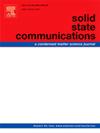圆柱形纳米点的剩余磁性结构
IF 2.4
4区 物理与天体物理
Q3 PHYSICS, CONDENSED MATTER
引用次数: 0
摘要
确定圆柱形纳米点的磁化状态是单畴构型(SD)还是涡旋态(VX)在广泛的跨学科应用中至关重要。在本工作中,我们通过微磁模拟研究了不同厚度下纳米点直径(D)和饱和磁化强度(MS)的SD和VX的存在性和共存性。我们从平面内和平面外磁滞回线确定了剩磁时的稳定磁构型。此外,我们还研究了考虑不同参数时的涡核半径RV。我们发现RV对厚度和饱和磁化强度有很强的依赖性,但对直径的依赖性较弱,对较大的直径的依赖性消失。对于本文研究的参数范围,我们发现在D > 100 nm时,RV与直径无关。本文章由计算机程序翻译,如有差异,请以英文原文为准。
Remanent magnetic configurations in cylindrical nanodots
Determining whether the magnetization of cylindrical nanodots is in a single domain configuration (SD) or a vortex state is crucial in a wide range of interdisciplinary applications. In this work we investigate the SD and existence, and their coexistence, in terms of the nanodot diameter () and its saturation magnetization () for different thicknesses, by means of micromagnetic simulations. We determine the stable magnetic configurations at remanence, from both in plane and out of plane hysteresis loops. Additionally, we investigate the vortex core radius in terms of different parameters considered. We find that is strongly dependent on the thickness and the saturation magnetization but the dependence is weaker on the diameter, vanishing for the larger ones. For the range of parameters studied in this work, we find that is diameter independent for 100 nm.
求助全文
通过发布文献求助,成功后即可免费获取论文全文。
去求助
来源期刊

Solid State Communications
物理-物理:凝聚态物理
CiteScore
3.40
自引率
4.80%
发文量
287
审稿时长
51 days
期刊介绍:
Solid State Communications is an international medium for the publication of short communications and original research articles on significant developments in condensed matter science, giving scientists immediate access to important, recently completed work. The journal publishes original experimental and theoretical research on the physical and chemical properties of solids and other condensed systems and also on their preparation. The submission of manuscripts reporting research on the basic physics of materials science and devices, as well as of state-of-the-art microstructures and nanostructures, is encouraged.
A coherent quantitative treatment emphasizing new physics is expected rather than a simple accumulation of experimental data. Consistent with these aims, the short communications should be kept concise and short, usually not longer than six printed pages. The number of figures and tables should also be kept to a minimum. Solid State Communications now also welcomes original research articles without length restrictions.
The Fast-Track section of Solid State Communications is the venue for very rapid publication of short communications on significant developments in condensed matter science. The goal is to offer the broad condensed matter community quick and immediate access to publish recently completed papers in research areas that are rapidly evolving and in which there are developments with great potential impact.
 求助内容:
求助内容: 应助结果提醒方式:
应助结果提醒方式:


